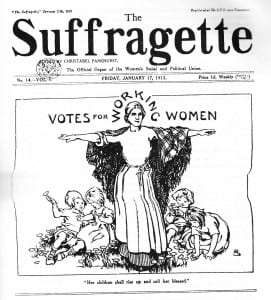I re-read a study book about votes for women, wanting to find out more about why women wanted the vote, reasons for and against and the suffragette’s protests. I found out quite a lot about the movement.
Reasons for the vote
Women wanted the vote, not just for political reasons, but because they believed it would end economic, social and moral unfair treatment they faced. They believed without the right to vote they were at a disadvantage, but with it their lives would be benefited, including improvement to marriage laws, sexual morals, it would also improve the lives of working class women and they believed that it would eliminate prostitution.
Cover of ‘The Suffragette’ Newspaper in 1913, supporting votes for women and showing it would be positive for working class women.
Reasons against the vote
A few ‘anti-suffrage’ quotes in the book, I found irritated me, over 100years later…
‘Men are governed by reason, Women by emotion’
‘Votes for Women? We shall be asked next to give votes to our horses and dogs.’
‘Women are guided by their wombs, rather than brains’
…Yes we live in a modern culture, but women are still women and shouldn’t have been treated as second class citizens. These quotes, even today are still very bitter and frustrating.
An argument against women being able to vote is that if they can’t fight and defend their country then they shouldn’t be able to vote either. Their role was seen to be a wife and mother. To give them the vote could ‘destroy’ family life and therefore destroy society, as the family was seen as a central part of society. The antis believed that women would challenge men’s authority and were unable to have an individual opinion. Women were perceived as too delicate to be involved with the dirtiness of politics and to be involved with it was believed to cause loss of the moral and social order of society.
The WSPU and militancy
After seeing slow progress and believing that politicians took little notice of the votes for women campaigns, the WSPU, (led by Emmeline Pankhurst) decided to go for a more militant approach, believing to gain the right to vote, force would be necessary.
Their forceful and militant actions included:
- Smashing windows – originally done out of desperation, but became official policy
- Setting fire to property/Arson attacks – not to cause harm to people but to protest against them, including David Lloyd George
- Destruction of a postbox – by Emily Davidson
- Destroying expensive works of art – including Mary Richardson slashing ‘Venus’ by Velazquez, with an axe, to say people care more about paintings than people
- Cut telegraph wires
- Wrecked plants in Royal Botanical Garden at Kew
- Chained themselves to railings in protest in the House of Commons and outside Downing Street
- Hunger strikes
- Imprisonment
- Put themselves in danger of physical harassment
Some might say the Suffragette’s actions were more like minor terrorism than traditional political protest.
I think the Suffragettes were very extreme in their actions and some argue it hindered the cause, nether the less it was a difficult time and women were not treated fairly, but as second class citizens and these women stood up against this unfairness for what they believed was right and just.
Source:
- Access to history: ‘Votes For Women’ by Paula Bartley (published by Hodder Education, 2007)
